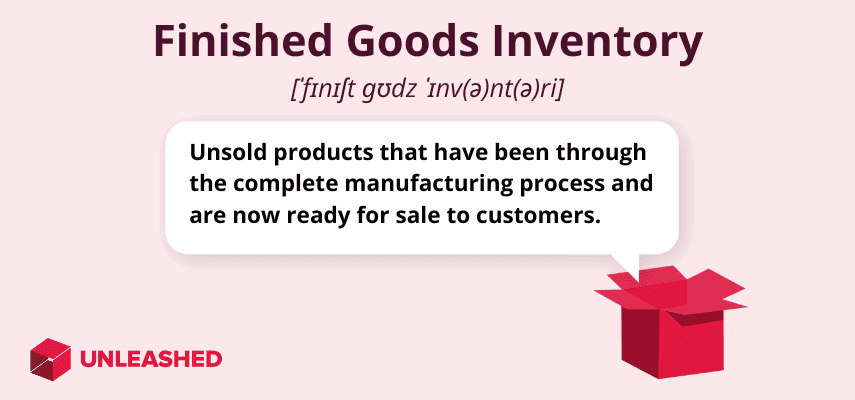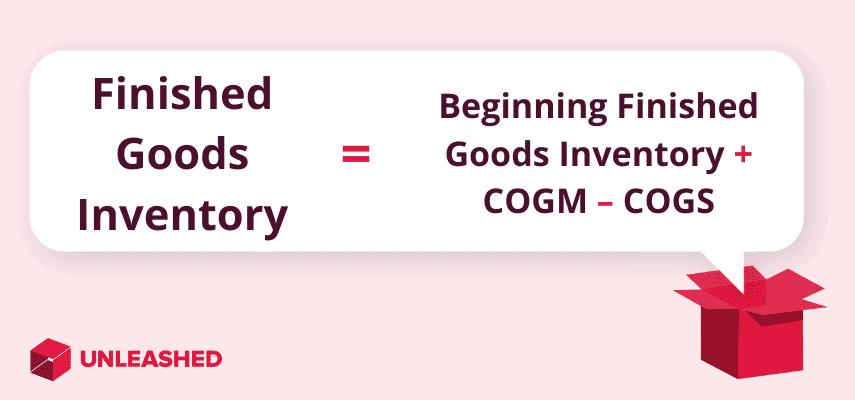
Finished goods inventory are products that have been through the manufacturing process and are now ready for sale. Managing finished goods and tracking the costs associated with each of them are essential aspects of manufacturing accounting and stock control.
This article breaks down how finished goods are calculated and some key inventory management methods for tracking them as they move through your business.
What are finished goods inventory?
Finished goods inventory refers to unsold products that have gone through the complete production process and are ready for sale to customers. They are made from raw materials and components and may be produced in bulk (mass production or batch production) or independently (one off production).
Common examples of finished goods inventory include:
- Fast-moving consumer goods
- Electronics
- Clothing
- Healthcare products
- Homeware
- Vehicles
Retailers will typically refer to finished goods as merchandise inventory.

Finished goods inventory in accounting
The finished goods inventory measure is important for accounting purposes because it represents current assets and potential profit for your business. It also helps you to manage your supply chain and avoid material waste by tracking how long it takes to produce a product.
In accounting, finished goods inventory is the specific number of inventory or manufactured items that you currently have in stock available for customers to purchase.
The finished goods inventory formula is critical for deriving accurate inventory levels.
Finished goods inventory is reported as a current asset on your balance sheet. It helps you to determine how much of your inventory accounts are short-term assets that can quickly be converted to cash or expected to generate a profit.
How to calculate finished goods inventory
The easiest way to calculate finished goods inventory is to use the finished goods inventory formula. The finished goods inventory formula is a calculation you can use to determine how many inventory items you manufacture or the number of products you hold ready for sale.
Finished goods inventory formula
The formula for determining your finished goods inventory is:
Beginning Finished Goods Inventory + Cost of Goods Manufactured - Cost of Goods Sold = Finished Goods Inventory
This formula shows how much inventory you have left at the end of the accounting period after you have accounted for your production and sales activities.
Here’s how it works:
- Beginning finished goods are the inventory items that are ready for sale at the start of the accounting period.
- Cost of manufactured goods is the expenses incurred to produce the finished goods within your accounting period.
- Cost of goods sold are the expenses related to the sale of those finished goods during the accounting period.
The cost of raw materials and the cost of converting them into finished goods inventory are recorded as inventory costs in your accounting system.
Inventory costs affect the profitability and cash flow of a business. That’s why managing inventory efficiently is a crucial process for optimising production and sales performance in your business.

How do raw materials become finished goods inventory?
Raw materials are the basic inputs that are used to produce finished goods. Finished goods inventory are the products that are ready for sale to your customers.
The process of transforming raw materials into finished goods inventory involves several steps, as described below.
Step 1: Raw materials procurement
One of the first activities of a manufacturing business is to obtain the raw materials needed to produce a finished good. These raw materials can be purchased from suppliers or extracted from natural resources.
Purchasing raw materials from a supplier involves the negotiation of prices, contracts, and delivery terms. Extracting raw materials from natural resources involves mining, drilling, harvesting, or other methods of extraction, activities that are likely to be legislated, or require licenses and approvals.
Both options have advantages and disadvantages in terms of cost, quality, availability, and environmental impact.
Step 2: Raw materials inventory management
Managing the supply chain of a manufacturing business requires storing your raw materials inventory in your warehouse or stockroom until they are needed for production by your operations team. This can help reduce your risk of running out of materials, avoid price fluctuations, and ensure quality control.
However, storing your raw materials inventory does have some drawbacks, such as increased inventory costs, storage space limitations, and the possible deterioration or obsolescence of materials over time.
Step 3: Production
Transporting the raw materials from their source or storage locations to your production facility is a crucial step in manufacturing. This is where the raw materials are prepared for various manufacturing processes that change their properties, shape, or function.
For example, some materials may be assembled into larger structures, while others may be integrated with other components to form complex products. Others can be transformed by heat, pressure, or chemical reactions to be converted into finished goods inventory.
Step 4: Quality control
Inspecting, testing, and packaging the finished goods inventory according to quality standards and customer specifications is another important aspect of the production process.
Finished goods inventory should be inspected for any defects or damage, tested for its functionality and performance, and packaged securely and attractively.
These activities ensure you can be confident are delivering high-quality products that meet the demand and satisfaction of your customers.
Step 5: Distribution
Once your raw materials become finished goods inventory and have been inspected and tested for quality and compliance, the final stage is transporting these goods to the distribution centres or retail outlets where they will be sold.
The transportation mode, cost, and speed will depend on various factors such as product type, demand, location, and customer preferences.

Finished goods inventory management
Finished goods inventory management is the process of keeping track of the goods you have ready and available to sell to your customers. It helps you understand how much value your business holds in stock, meet consumer demand for your products, and avoid wasting money on excess stock or storage space.
9 benefits of managing finished goods inventory
Managing finished goods inventory is an important aspect of supply chain management. It allows you to keep track of how many products you have ready to sell to your customers.
Benefits of managing your finished goods inventory efficiently:
- Avoid stock-outs and lost sales opportunities which lead to dissatisfied customers and may damage your reputation.
- Reduce your costs of storing and handling excess inventory that takes up space and resources.
- Keep track of the demand and supply of finished goods to avoid overstocking items, which can lead to inventory waste or obsolescence costs.
- Improve your inventory turnover ratio – the measure of how quickly you sell your finished goods.
- Improve customer satisfaction levels by ensuring that you have enough products available to meet consumer demand.
- Ensure on-time deliveries that meet consumer expectations to enhance your customers’ loyalty, retention, and referrals.
- Increase operational efficiency by streamlining production and distribution processes and reducing errors and waste.
- Improve your forecasting accuracy, helping you to plan your future production and purchasing activities.
- Leverage your inventory data to identify trends, patterns, and opportunities for improvement.
Finished goods inventory management methods
Finished goods inventory management methods are the procedures and practices manufacturers use to track, control, and optimise inventory stock of finished products that are ready for sale.
Four common methods of managing finished goods inventory are:
- Just-in-Time (JIT): This method aims to minimize inventory holding costs by ordering and producing only what is needed when it is needed. The JIT method requires accurate demand forecasting and close coordination with suppliers and customers.
- Economic Order Quantity (EOQ): This method calculates the optimal order quantity to minimise the total inventory costs, which include ordering costs, carrying costs, and shortage costs. The EOQ method requires a constant demand rate and a fixed order lead time.
- Average costing: This method calculates the cost of goods sold by dividing the total cost of inventory by the number of units in stock. This method is simple to use but does not reflect the actual cost of each unit sold.
- Cycle counting: This method involves regularly counting a small portion of the inventory to ensure accuracy and identify discrepancies. This method reduces the need for a full physical inventory count and improves inventory control.
Finished goods inventory management tools
Finished goods inventory management tools are software applications that support the inventory management methods you have chosen to implement into your business.
They help you to:
- Avoid stockouts and overstocking
- Reduce waste and spoilage of your inventory materials
- Optimise your cash flow and working capital
- Streamline production planning and ordering processes
- Enhance operational efficiency and accuracy
- Simplify compliance and auditing
Finished goods inventory management tools are essential for optimising your inventory and minimising stock-holding costs.
Finished goods inventory management software features
Finished goods inventory software comes in many forms, with different features for various applications and industries.
Here are some of the key functions to look for:
- Real-time inventory tracking: See where your available stock is and how much of each item is currently available
- Accurate inventory accounting: Get a live view of your profits, sales, and costs and compare financial data to identify key trends
- Bill of materials management: Trace the status of finished goods inventory throughout the entire production process, from raw materials to end product
- Barcode scanning: Streamline inventory management and boost stock accuracy with barcode inventory management
- Demand forecasting: Analyse historical sales data and inventory trends to identify optimal stock levels and minimise your inventory costs
For a more detailed overview of how finished goods inventory management software works, check out this short demo:
- Ready to optimise your inventory control? Get started with a free 14-day trial of Unleashed today.
